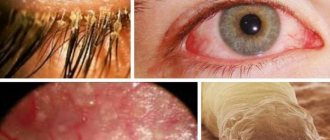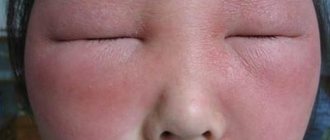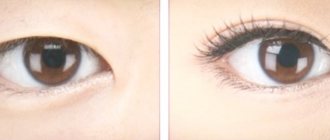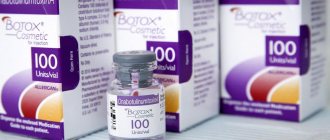Swelling of the eyelid in one eye and other symptoms of inflammation
In this article
- Swelling of the eyelid in one eye and other symptoms of inflammation
- Causes of swelling of the eyelid of one eye
- Diseases that cause swelling
- Treatment of eyelid edema
- Treatment with traditional methods
- Prevention of edema
Let us immediately note that if the swelling of the eyelid is not accompanied by other symptoms, then it can be caused by an uncomfortable posture during sleep or an eye injury. One of the causes of swelling of one eyelid is lack of sleep, but in this case it goes away within a few hours. In other situations, it can signal pathologies of a different origin.
As a rule, swelling is accompanied by redness of the eyelid and eyeball. Sometimes it occurs due to the structural features of the eyelid of one eye: the skin on it may be somewhat thinner than on the other.
You should immediately consult a doctor if swelling of the lower or upper eyelid in one eye is accompanied by:
- severe itching that does not subside over time;
- painful sensations;
- redness of the eyelid and eye;
- excessive secretion of tears;
- purulent or mucous discharge.
Load on vision and mucous membranes
Another common cause of swelling under the left eye is prolonged strain on the visual organs. For example, during prolonged reading in poor lighting, working at a computer with insufficient or irregular rest, prolonged driving of a car or other vehicle.
As a result of all these reasons, the muscles that are located around the eyes are in constant tension. This causes problems with blood flow in the eyelids. Blood fluid penetrates beyond the blood vessels, saturating the skin, which leads to puffiness under the eyes. As a result, blood flow may deteriorate further.
Aggressive substances, affecting the mucous membrane, provoke swelling under the eye on the left side. This could be smoke or vapor from a caustic solution. A similar situation occurs when a foreign object hits the eyeball. A person begins to cry for a long time and severely, which is caused by emotional shock. As a result, there is an increased flow of blood and tear fluid to the loose tissue around the eye with subsequent accumulation in it.
Puffiness under the eyes also occurs due to sleep problems. Deficiency, constant interruptions, sleeping without a pillow or simply in the wrong position. For example, when the head is lowered down, which disrupts the outflow of lymph and blood from the head. All these factors also provoke swelling.
Causes of swelling of the eyelid of one eye
As mentioned above, swelling of the eyelid in one eye is evidence of the development of infectious or viral diseases. Swelling occurs as a result of a violation of the water-salt balance. Also, swelling in one eye can develop as a result of:
- allergic reactions (due to point contact with an allergen or insect bite);
- leakage of cerebrospinal fluid;
- eye strain;
- problems with the thyroid gland;
- problems with blood flow;
- pathological processes in blood vessels, kidneys or heart.
Concealing bruises
The technology for visually hiding a hematoma on the face is the same for both a painful injury and a cosmetic defect that prevents you from being beautiful in the morning. If there is a risk of failing an interview, an important meeting or a festive event, because a black eye received the day before takes a long time to disappear, special makeup will help you.
The video will tell you how to remove a five-day-old hematoma from the area between the eyebrows and eyelid:
No less problematic is the elimination of the consequences of damage to the bridge of the nose, a severe head injury, as well as an illness that is not associated with physical damage, but affects the functioning of the entire body, which is why bags and dark circles appear under the eyes. A combination of the right eyeshadow color will help remove them.
In the video you will find tips on grouping cosmetics to hide morning dark circles under the eyes:
Diseases that cause swelling
What diseases can be accompanied by swelling of the lower or upper eyelid of one eye? There are quite a lot of them, but the most popular of them are:
- Stye: during it, an abscess appears on the lower or upper eyelid of one eye, which is very painful. The skin of the affected eyelid turns red, sometimes the body temperature rises, and fever occurs. The swelling goes away after the purulent contents come out of the formation.
- Conjunctivitis - swelling can also occur in one eye, although most often both eyelids swell.
- Dacryocystitis is a disease in which obstruction of the lacrimal canaliculus occurs in one eye, resulting in inflammation. Dacryocystitis can be acute and chronic: in acute cases, the swelling is quite severe, while chronic dacryocystitis is characterized by moderate swelling of the eyelids. Also, when pressed, pus may come out of the affected lacrimal canaliculus.
- Blepharitis - quite often has a unilateral form, so swelling of the upper eyelid of one eye may occur. Pain and redness of the eyelids, which are standard for eye diseases, are complemented by loss of eyelashes. If the disease is not noticed in time, it can spread to the conjunctival membrane, which negatively affects the quality of vision.
5. Allergies to insect bites, low-quality cosmetics, foods, pollen, medications, etc. In this case, the main thing is to quickly identify the allergen and exclude the patient’s contact with it. After this, as part of treatment, the patient needs to take antihistamines and decongestants.
Possible complications
Complications and consequences can sometimes be irreversible, that is, it is not always possible to eliminate them and restore former vision, even with the help of the most modern means and technology. If timely medical care is ignored, the patient may encounter the following conditions:
- Exophthalmos. This is a forward displacement of the eyeball. In this case, a person begins to experience difficulty moving his eyes, and this in turn leads to a certain limitation of activity in a person’s life. In order to look at the object, he has to turn his body, but he cannot achieve the same reaction. Therapy for this condition in most cases includes surgery, as well as the use of local drugs and treatment of the underlying disease, which became the basis of this pathological condition.
- Chemosis of the conjunctiva. This is severe swelling of the tissues of the mucous membrane of the eyeball. This leads to blurred vision, the formation of a “whitish veil” before the eyes, which will ultimately gradually lead to a permanent decrease in visual acuity. A person experiences discomfort even with his eyes closed. In severe cases, the process may be accompanied by the discharge of pus.
Complications of sinusitis and sinusitis are the spread of infection in the brain tissue, and these are very serious conditions that are not always compatible with life and almost always involve abandoning the usual active life and very long and complex rehabilitation.
Finally, increased swelling without appropriate treatment provokes an increase in intraocular pressure, and this is a direct threat to decreased visual acuity and even blindness.
It is impossible not to mention complications from improper therapy. For example, self-administration of diuretics can lead to disruption and even failure of the excretory system. This is a very dangerous condition, which will subsequently require the patient to remain in hospital for a long time, but even in this case there is no complete guarantee that the system will return to functioning.
And of course, for almost every person the aesthetic component of his appearance is important. The presence of puffiness under the eye can give others the wrong idea about this person, which gives limitations (for example, in the professional sphere).
Treatment of eyelid edema
You can relieve swelling by using decongestants. However, it is important to determine the cause of swelling of the upper or lower eyelid, and only a specialist can do this, so at the first alarming symptoms you should visit the clinic.
If swelling has developed as a result of an allergic reaction, the specialist will prescribe antihistamines and hormonal drugs in the form of drops and ointments. Most often, doctors recommend using hydrocortisone ointment, opatanol, cromohexal.
If the cause of the swelling is bacteria, drops and ointments are used that have an antibacterial effect - they eliminate the pathogenic microflora that provokes the development of edema.
Antibiotics are selected based on the patient’s age, stage of the disease and the cause of its occurrence. For barley and blepharitis, ointments are used that are placed under the eyelid three times a day: for these diseases, drops do not help much. Treatment lasts for about a week.
For disinfection, you can use boric acid, which is dissolved in water (5 g per 100 g of boiled water). You need to rinse your eyes with this solution up to 3 times a day.
You can also take tablets with a decongestant effect: Claritin, Zodak, Tavegil.
Causes
In some cases, the factors that provoke the occurrence of swelling are quite harmless and do not pose a threat to health. Such reasons include:
- genetic predisposition;
- age characteristics;
- pregnancy;
- lack of sleep;
- frequent consumption of salty foods or alcoholic drinks;
- use of cosmetics.
Swelling may appear during illness. Diseases that often cause them:
- pathologies of the endocrine or cardiovascular system;
- allergy;
- kidney disease;
- conjunctivitis;
- eye injuries.
What is the difference between swelling and bags under the eyes?
These two cosmetic defects look similar, which is why many people do not differentiate between them. However, this approach is misleading. If edema is, in fact, an accumulation of fluid in the lower eyelid area, then the bags are the result of the formation of an abnormal layer of fatty tissue, which is normally located only inside the orbit.
Accordingly, the approach to treatment will differ fundamentally. In case of edema, a noticeable improvement is achieved already at the stage of using conservative means (compresses, creams, massage). Removal of the bags is only possible through surgery.
Treatment with traditional methods
In addition to medications, traditional medicine methods will help relieve swelling from the eyelid. The use of each of them must be agreed with the doctor and correctly included in the treatment regimen.
Some remedies are listed below:
- Pour 20 grams of finely chopped fresh parsley with a glass of boiling water and leave for half an hour for the broth to infuse. Divide the liquid into equal parts and drink it three times a day. You should not prepare the product for future use: the infusion must be fresh.
- Make a decoction of chamomile, calendula, mint and freeze it in ice cube trays. Wrap the resulting cubes in gauze and keep on the swollen eye for 5 minutes. You should not keep the compress for more than the specified time: this can cause damage to blood vessels. Repeat the procedure three times a day. Using a frozen decoction, you can not only remove puffiness from the lower and upper eyelids, but also restore skin color.
- Grate the apple on a fine grater, wrap it in gauze and place it on your eye. Apple juice should get on the damaged eyelid, so the gauze should be folded into no more than two layers. The procedure time is 15 minutes.
- Grate equal amounts of carrots and parsley, mix them and apply this paste to your closed eyes for 15 minutes. Afterwards, rinse it off with cool water.
5. A cucumber-honey mask is also quite effective, but in this case it is important to make sure that there is no allergic reaction to honey. To prepare it, you need to mix honey and cucumber juice in a ratio of 1:2. The resulting mixture is applied to the swollen eyelid for 10 minutes.
Characteristic symptoms
The clinical picture is directly dependent on the causative disease. If you have blepharitis or an infection, your eyelids will begin to itch and develop red spots. If you have an allergic reaction to cosmetics or nutritional products, burning and itching may occur. With Quincke's edema, phlegmon or conjunctivitis, visual acuity can significantly decrease.
Prevention of edema
If inflammatory processes have begun, it will not be possible to avoid eyelid swelling in one eye (or both at once). However, certain measures will help reduce the likelihood of its occurrence. Among these measures:
- giving up bad habits and following the principles of a healthy lifestyle;
- proper nutrition: eating plenty of fruits and vegetables and reducing the amount of fatty foods in the diet;
- healthy and regular sleep of at least 6 hours;
- regular ventilation of the living space.
If you suspect the development of diseases, you must immediately contact a specialist without wasting time on self-medication. Remember that self-prescribing medications can cause serious problems. Even if it is possible to remove swelling from the lower or upper eyelid without the help of a specialist, the cause of its occurrence will remain unidentified. An untreated disease can lead to serious complications, which will be much more difficult to get rid of.
Express tips for relieving puffiness
If the swelling increases in size, or additional complaints arise, contact a specialist.
You can quickly eliminate swelling under the eye using cold lotions. Any cold product (for example, from the refrigerator) or a regular tablespoon will work perfectly. Cold causes vasoconstriction, thereby helping to reduce swelling and redness on the skin. The only contraindication for the compress is an ongoing inflammatory process (for example, barley).
You can eliminate morning swelling with a massage using your ring fingers. It is also good to lightly tap the area with swelling, as well as rubbing and circular movements with your fingers. It is recommended to massage with eye cream.
An excellent remedy is a compress made from pre-chilled tea bags. The package is applied to the affected area and left for 20 minutes. A lotion made from fresh cucumber will also be effective.











